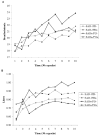Carbon dioxide hypersensitivity in separation-anxious offspring of parents with panic disorder
- PMID: 20172505
- PMCID: PMC3617557
- DOI: 10.1016/j.biopsych.2009.12.014
Carbon dioxide hypersensitivity in separation-anxious offspring of parents with panic disorder
Abstract
Background: Similar patterns of vulnerability to carbon dioxide (CO(2)) inhalation have been reported in adults with panic disorder (PD) and children with separation anxiety disorder (SAD), suggesting a link between the adult and child conditions. This study examines the influence of familial risk for PD on CO(2) responses in children with SAD. We hypothesized that offspring with SAD of parents with PD would have distinct CO(2) responses.
Methods: Two hundred twelve 9- to 20-year-old offspring of parents with or without PD were exposed to maintained 5% CO(2) inhalation in the participants' homes. Anxiety symptoms, panic attacks, and respiratory physiology (respiratory frequency and tidal volume) were monitored during baseline and 15-min maintained CO(2) breathing.
Results: As hypothesized, significant offspring SAD x parent PD interactions were obtained for anxiety symptoms, respiratory frequency, tidal volume, and a panting index during CO(2) inhalation. Offspring with both SAD and parental PD exhibited more anxiety symptoms at termination of 5% CO(2) breathing than the other offspring groups and had the most extreme values on measures of respiratory physiology.
Conclusions: Youth with both SAD and parental PD have respiratory responses to CO(2) similar to adult PD. They might be a subtype of SAD at particularly high risk for adult PD.
Figures



Similar articles
-
Response to 5% carbon dioxide in children and adolescents: relationship to panic disorder in parents and anxiety disorders in subjects.Arch Gen Psychiatry. 2005 Jan;62(1):73-80. doi: 10.1001/archpsyc.62.1.73. Arch Gen Psychiatry. 2005. PMID: 15630075
-
Relationship between separation anxiety disorder, parental panic disorder, and atopic disorders in children: a controlled high-risk study.J Am Acad Child Adolesc Psychiatry. 2002 Aug;41(8):947-54. doi: 10.1097/00004583-200208000-00013. J Am Acad Child Adolesc Psychiatry. 2002. PMID: 12162630
-
Differential carbon dioxide sensitivity in childhood anxiety disorders and nonill comparison group.Arch Gen Psychiatry. 2000 Oct;57(10):960-7. doi: 10.1001/archpsyc.57.10.960. Arch Gen Psychiatry. 2000. PMID: 11015814
-
A neurobiological framework of separation anxiety and related phenotypes.Eur Neuropsychopharmacol. 2020 Apr;33:45-57. doi: 10.1016/j.euroneuro.2020.01.009. Epub 2020 Feb 8. Eur Neuropsychopharmacol. 2020. PMID: 32046934 Review.
-
Psychopathology in children of patients with panic disorder or animal phobia.Psychopathology. 1998;31(2):69-84. doi: 10.1159/000029026. Psychopathology. 1998. PMID: 9561550 Review.
Cited by
-
Evidence that the periaqueductal gray matter mediates the facilitation of panic-like reactions in neonatally-isolated adult rats.PLoS One. 2014 Mar 3;9(3):e90726. doi: 10.1371/journal.pone.0090726. eCollection 2014. PLoS One. 2014. PMID: 24594924 Free PMC article.
-
Acid-base dysregulation and chemosensory mechanisms in panic disorder: a translational update.Transl Psychiatry. 2015 May 26;5(5):e572. doi: 10.1038/tp.2015.67. Transl Psychiatry. 2015. PMID: 26080089 Free PMC article. Review.
-
Genetic and Environmental Contributions of Negative Valence Systems to Internalizing Pathways.Twin Res Hum Genet. 2018 Feb;21(1):12-23. doi: 10.1017/thg.2017.72. Twin Res Hum Genet. 2018. PMID: 29369039 Free PMC article.
-
Separation anxiety: at the neurobiological crossroads of adaptation and illness.Dialogues Clin Neurosci. 2015 Sep;17(3):277-85. doi: 10.31887/DCNS.2015.17.3/mbattaglia. Dialogues Clin Neurosci. 2015. PMID: 26487808 Free PMC article. Review.
-
Evidence for distinct genetic effects associated with response to 35% CO₂.Depress Anxiety. 2013 Mar;30(3):259-66. doi: 10.1002/da.22038. Epub 2013 Jan 24. Depress Anxiety. 2013. PMID: 23349098 Free PMC article.
References
-
- Gorman JM, Fyer MR, Goetz R, Askanazi J, Liebowitz MR, Fyer AJ, Kinney J, Klein DF. Ventilatory physiology of patients with panic disorder. Arch Gen Psychiatry. 1984;45:31–39. - PubMed
-
- Kent JM, Papp LA, Martinez JM, Browne ST, Coplan JD, Klein DF, et al. Specificity of Panic Response to CO2 Inhalation in Panic Disorder: A Comparison With Major Depression and Premenstrual Dysphoric Disorder. Am J Psychiatry. 2001;158:58–67. - PubMed
-
- Papp LA, Klein DF, Gorman JM. Carbon dioxide hypersensitivity, hyperventilation, and panic disorder. Am J Psychiatry. 1993;150:1149–1157. - PubMed
-
- Sanderson WC, Rapee RM, Barlow DH. The influence of an illusion of control on panic attacks induced via inhalation of 5.5% carbon dioxide-enriched air. Arch Gen Psychiatry. 1989;46:157–162. - PubMed
-
- Klein DF. Panic and Phobic Anxiety: Phenotypes, Endophenotypes, and Genotypes. Am J Psychiatry. 1998;155:1147–1149. - PubMed
Publication types
MeSH terms
Substances
Grants and funding
LinkOut - more resources
Full Text Sources
Medical
Research Materials

